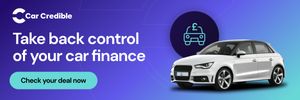Breaking down is one of the worst - and quite often scariest - things you'll ever experience as a driver.
It's something that could happen at any time and you need to have your wits about you if it ever happens to you.
On faster roads and motorways, in particular, it can be a stressful experience, but the same could be said about slow-moving traffic when you feel like you're disrupting everyone else's day.
Do you know your car's equity position? Find out today by signing up to Car Credible for a full car finance appraisal.
It's a real-life situation you should always be prepared for and it's definitely worth doing some research just in case it ever happens to you.
That's why we've put together this article to help you get a clear understanding of what to do if you find yourself in particular circumstances.
Breakdown cover
It's really critical that you sort out some form of breakdown cover for your car, just in case the worst was to happen.
If you did breakdown without cover, you could still call out a breakdown service, however, the likelihood is you'll have to pay a considerable amount for the privilege.
You can get breakdown cover for a reasonable price that can be paid in one lump sum or on a monthly basis to help with the costs.
Breaking down on the motorway
If your vehicle is still capable of moving, then try to exit the motorway if possible, whether it be a junction, a service area, or a hard shoulder.
This will make it easier for breakdown services to get to you and help you get back on the road.
Regardless of where your car does come to a stop, you should put your hazard lights on to let other drivers know you are experiencing difficulty, both at night and during the day.
If you are only able to make it to the hard shoulder, you should turn your wheels to face the left-hand side and ensure your car is as far away from the carriageway as possible.
You should also step over the safety barrier facing the oncoming traffic, as this will allow you to be aware of your surroundings. Only then should you call the breakdown service.

Breaking down on a smart motorway
Smart motorways have received a lot of criticism over their designs often being regarded as unsafe.
These types of motorways remove the hard shoulder as a safe stopping point if a vehicle breaks down, replacing it with an active running lane.
It means that if you break down and there is no opportunity to get to a service area or junction, you could be left stranded in the middle of a fast-moving lane.
They do have emergency refuge areas (ERA) situated every half a mile or so, but it's not the same as having a designated space to pull into if you need to.
If you aren't able to get off of the motorway or find an ERA, then try to get as far left as you can. If you are able to do this then you should climb over the safety barrier and call the emergency services.
If your car is in a live lane and you can't get out safely, you should keep your hazard lights and seat belt on and call 999.
New camera usage to keep road users safe has been installed and if you are seen on CCTV, the lane you are in will be closed and made known to other drivers that they can't use the one you are stranded in.
Breaking down on an A-road or dual carriageway
It can be equally as daunting to break down on a fast-moving A-road as it can on the motorway, and the protocols you should follow are very much the same.
If you are able to get off of the carriageway then that should be the priority, but if not, getting as far left or into a lay-by is advised.
Hazard lights should be used and then you can call your breakdown cover provider.
Get out of your car and stand away from the traffic if possible, and put a warning triangle behind your car at a distance of around 45 metres.
Breaking down in a town or city centre
If your breakdown is causing a backlog of traffic then it can be an incredibly stressful situation to be involved in.
It's important that if you feel your car start to break down, try and get yourself into a parking space or down a side street away from the hustle and bustle.
Like other, faster roads, you should still put your hazard lights on and call for help when it is safe to do so.
Preparing for a breakdown
Ahead of a long journey, ensure your tyre pressures are what they should be, you have enough fuel in the tank and be aware of when you may need to fill up again, and just do a general maintenance check of the vehicle.
If you don't already have breakdown cover then get it sorted immediately to give you the protection just in case.
If you notice any warnings on your dashboard, or something seems a little off, then don't ignore it as it may lead to something more serious if left unattended.
It's worth having a breakdown kit in your car, including a warning triangle in particular as you never know who you might need to use it.
/car-broken-down.jpg)


/car-tax-disc-image2.jpg)
/money-saving-tips.jpg)
/car-tax-sorn.jpg)